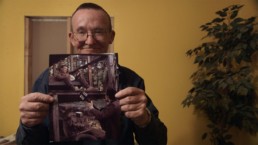‘hillbilly’ and ‘Behind the Curve’ Reviews: Fringe Groups Seeking to be Seen
This is a custom heading element.
One of the things that bubbled up during the 2016 Presidential campaign and then all but burst afterward was the talk of a deep cultural divide in America.
This divide might be explained by a few things. Minority groups, whose voices had previously not been heard, have risen and social movements have gained nation-wide attention in true democratic fashion ushered in by the digital age. People’s stories are being told and shared to the larger masses easier than ever before, both online and in media representation. Being open to hearing other sides of arguments can be an uncomfortable thing. Educational nonetheless. In order to run the country in a civilized and democratic fashion, we should be open to understanding the effects of harmful stereotypes minorities face, and we should be open-minded when we hear people say that the Earth is not round, but flat.
Well, perhaps not the latter.
At this year’s LA Film Festival, two documentaries examined people who are trying to be seen as legitimate groups in American society. hillbilly, directed by Sally Rubin and Ashley York, follows the progressive feminist filmmaker York as she returns to her hometown on the eve of the 2016 Presidential election. Here, she examines the harmful stereotype of hillbillies that she and her family and friends have had, and still have, to endure for decades. hillbilly is an example of a social documentary where the filmmaker seeks to re-appropriate the harmful stereotype while showing how the longlasting effects on those ostracized have led to marginalized political voices.

Of course, where a film like hillbilly seeks to actively re-frame harmful stereotypes, the documentary Behind the Curve, directed by Daniel J. Clark, is a light-hearted look at showing the quirkier folks who believe in a flat-earth. Now I wouldn’t want to undermine my entire argument that these flat-earthers should be made fun of, but as Clark so deftly shows in his movie, it requires an incredulously naive person to believe these people. Where a conspiracy theory movie could have easily played like a hard-nosed investigative take-down, Behind the Curve is successful because it’s more of a curious, almost empathic look at this group of people who are oddballs in their own right. Among a community of fellow weirdos, these flat-earthers feel a sense of rightness and belonging.
Hearing things that go against our natural inclination can be hard. We might feel a personal attack on ourselves, and I’d be lying if I, a young Californian kid whose vote didn’t go toward the current President of our country, didn’t feel that hillbilly was initially not a sad story, especially compared to the more wronged minority groups that Black Lives Matter or #MeToo have positioned themselves to be. But co-director Ashley York is the perfect person to bring this story to light, being a progressive filmmaker who couldn’t be more different than her “MAGA” family. But York proudly identifies as a hillbilly, while simultaneously getting her family to open up to what they see as Coastal elitism devaluing the Appalachian people and their ways of life. It’s comical to see the image of the hillbilly in popular culture – straw hat, toothless, and illiterate – but York shows that this ignorant representation also does harm by undermining these people’s civil and political rights.
It’s not as hard to hear conflicting information presented by Flat-earthers, because – truly, objectively – it’s such a funny concept. And the people that make up this community, while distrustful of popular ideas and historical events, have a streak of animation to them. They are show people, proudly defiant of being on the fringe. A spectrum of people differs in terms of what a “flat earth” exactly that means – some believe that the sky is a dome covering, some believe that they’re in infinite space that expands upwards, and variations beyond that. These conspiracy theorists even differ with themselves, thinking that some of their own are operatives and undercover. But what Clark does so well is explain how astrophysicists and scientists need to re-position their arguments better so that they don’t alienate others on the outside.
Both documentaries are more than educational and worth your time. We need to continue to highlight the stories of people whose stories may differ from our own. Even if we are worlds away… and however flat those worlds may be.
‘hillbilly’ is not rated. 87 minutes.
‘Behind the Curve’ is not rated. 96 minutes.
Ryan Rojas
Ryan is the editorial manager of Cinemacy, which he co-runs with his older sister, Morgan. Ryan is a member of the Hollywood Critics Association. Ryan's favorite films include 2001: A Space Odyssey, The Social Network, and The Master.

